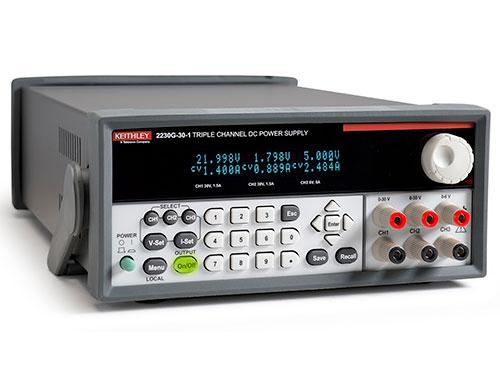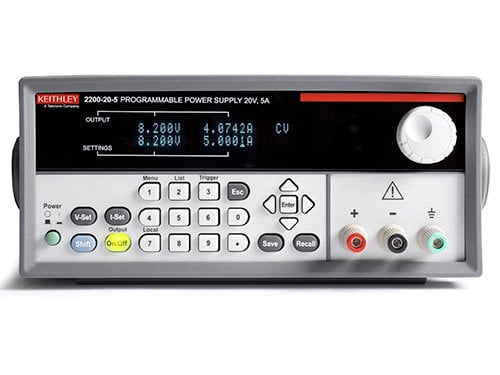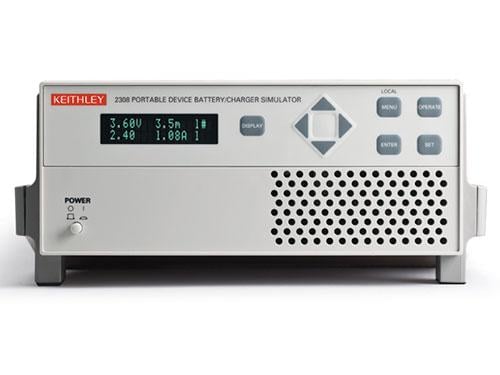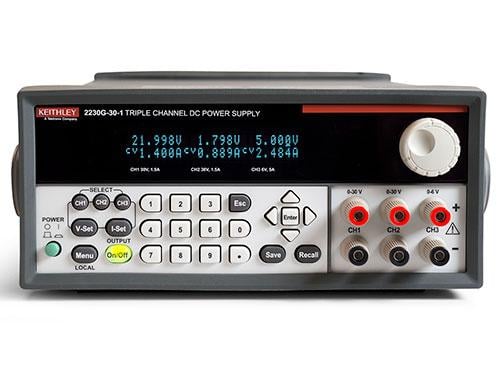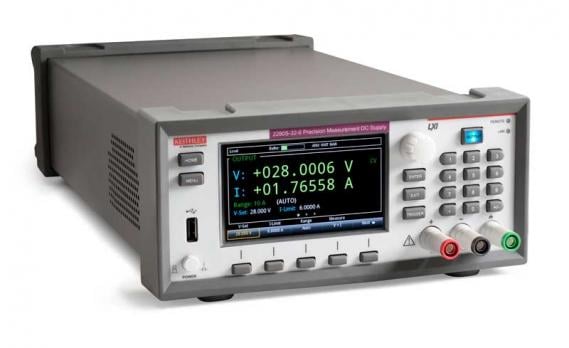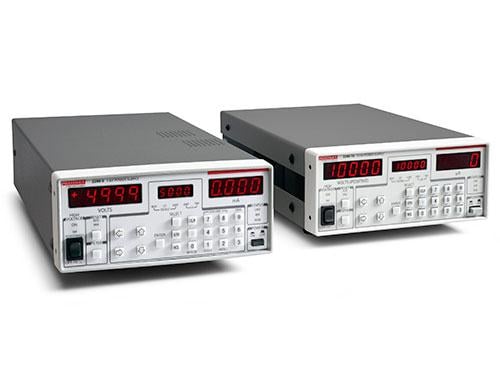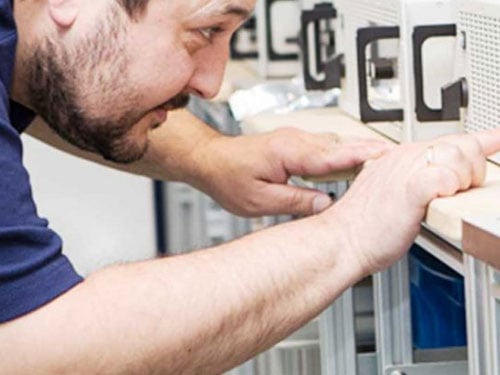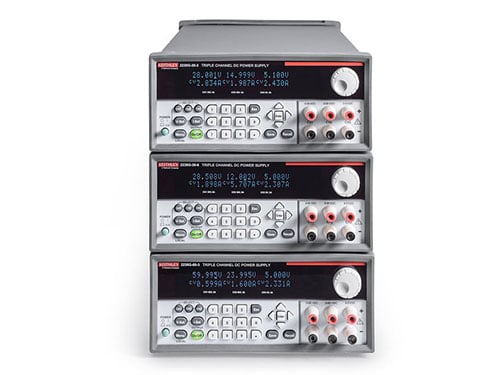Contact us
Live Chat with Tek representatives. Available 6:00 AM - 4:30 PM
Call us at
Available 6:00 AM – 5:00 PM (PST) Business Days
Download
Download Manuals, Datasheets, Software and more:
Feedback
Áp dụng máy cấp nguồn DC vào ứng dụng thực tiễn
Máy cấp nguồn DC được sử dụng trong nhiều lĩnh vực ứng dụng, từ đào tạo thế hệ kỹ sư điện tiếp theo đến phát triển các sản phẩm mang tính đột phá tiêu thụ công suất điện cực thấp phục vụ mục đích hằng ngày của con người. Do đó, lựa chọn máy cấp nguồn DC là khâu cực kỳ quan trọng giúp bạn đạt kết quả đo mong muốn, dù cho bạn chỉ cần máy với cấp điện cơ bản, hay máy có hiệu suất cao vượt qua mọi giới hạn để sẵn sàng cấp cho bạn hàng nghìn vôn.
Cách chọn bộ cấp nguồn DC tốt nhất
Tiêu chí lựa chọn phổ biến nhất là:
- Số kênh đầu ra (một hoặc nhiều đầu ra)
- Điện áp, dòng điện, và công suất đầu ra
- Độ phân giải và độ chính xác thiết lập
- Gợn sóng và nhiễu
- Tính năng và tính có thể lập trình
- Các tính năng nâng cao như đo dòng điện với độ phân giải nanoamp, sắp xếp trình tự, đầu vào analog, I / O kỹ thuật số và các tính năng lập trình

Featured DC Power Supply
EA-PSI 10000 Series: Precise, High-Performance
Delivering precise, adjustable power with high efficiency and autoranging capabilities, the EA-PSI 10000 Series is built for R&D, production, and test automation.
- Stable, Programmable DC Power – Precise voltage and current control
- Autoranging Flexibility – Maximizes power delivery across voltage levels
- High Efficiency – Reduces energy waste and heat output
- Remote Programmability – Ethernet, USB, and CAN for automated testing
Bộ cấp nguồn DC Keithley
Battery Testing & Simulation
High-Power & Specialized Applications
Browse Types of Power Supplies
How Engineers Use DC Power Supplies
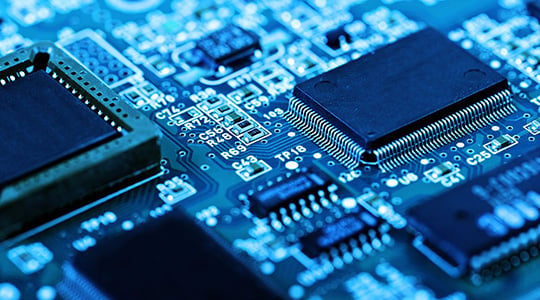
Circuit Design and Prototyping
Engineers rely on DC power supplies to provide stable, adjustable voltage during circuit design, allowing for component validation, performance tuning, and troubleshooting in early-stage development.
Production Testing and Quality Assurance
In manufacturing environments, DC power supplies help test PCBs, power electronics, and semiconductors, ensuring each product meets performance and safety standards before deployment.


Automated Test and Measurement Systems
With programmable control and remote operation, DC power supplies integrate into automated test setups, enabling fast, repeatable measurements across multiple devices and conditions.
Expert Tips for DC Power Supply Measurement
The 10 Stages of Design
Designing a reliable power supply requires careful planning, precise testing, and the right tools. Our Power Supply Measurement Tips guide walks you through the 10 essential stages of power supply design—from component selection to EMI troubleshooting and final validation. Whether you're optimizing efficiency, ensuring compliance, or troubleshooting issues, these expert insights will help you achieve better performance and faster time to market. And if you're selecting a new power supply, these tips will guide you in making the right choice. Because the best power supply isn’t just about specs—it’s about how you test and refine your design.

How to Choose the Right DC Power Supply
Selecting a DC power supply can be overwhelming with the range of options available, but breaking it down by application and essential features makes the decision much easier. Here’s what to consider when choosing the right power supply for your needs.
Step 1: Define Your Application
Before looking at specifications, start with the intended use case.
- General electronics testing – A standard benchtop power supply will work.
- Battery testing or simulation – A supply with bidirectional capabilities or a built-in battery emulator is necessary.
- High-power applications – If testing EV components or industrial equipment, a high-voltage, high-current, or autoranging supply is a better fit.
Step 2: Key Selection Criteria
Single vs. Multi-Output
- Single-output supplies are sufficient for straightforward applications requiring a single power source.
- Multi-output supplies are ideal for testing circuits with multiple voltage levels, reducing the need for additional equipment.
Voltage, Current, and Power Capacity
- Ensure the supply can meet both maximum and minimum voltage and current needs.
- Autoranging power supplies provide greater flexibility by adjusting voltage and current dynamically while maintaining full power output.
Precision and Stability
- Resolution and accuracy determine how finely voltage and current can be adjusted—critical for precision testing.
- Ripple and noise impact signal integrity, especially in sensitive analog or RF applications.
Programmability and Automation
- Basic control interfaces (USB, LAN, or GPIB) are sufficient for automated testing setups.
- Advanced features like sequencing, arbitrary waveform generation, and programmable load profiles allow for more complex testing.
- Analog and digital I/O enable integration with external control systems.
Step 3: Specialized Features for Specific Applications
- Battery Simulation and Testing – Power supplies that can simulate battery behavior allow for more accurate testing of power consumption and efficiency.
- Bidirectional Power Supplies – These can both source and sink power, making them ideal for energy storage systems and applications such as EV battery cycling.
- High-Voltage Power Supplies – For applications like semiconductor testing and insulation breakdown analysis, supplies capable of 1 kV or higher are required.
Step 4: Consider Long-Term Usability
Selecting a power supply is not just about meeting immediate requirements—it’s about ensuring flexibility and longevity.
- Scalability – Can it accommodate future testing needs?
- Versatility – Will it work across multiple applications, or is it too specialized?
- Durability – Is it built for long-term precision and reliability?
Need help finding the perfect DC power supply for your application?
FAQs for DC Power Supplies
What is a DC Power Supply?
A DC power supply converts AC power from the mains into a stable DC output. It can be regulated (to maintain a constant voltage) or unregulated, depending on the application.
Learn More:
What’s the difference between a DC power supply and an AC power supply?
What industries use DC power supplies?
DC power supplies are widely used across various industries, including:
- Electronics & Semiconductor Testing – Used for circuit validation, component characterization, and failure analysis.
- Automotive & Electric Vehicles (EVs) – Essential for battery testing, powertrain validation, and inverters.
- Aerospace & Defense – Used for high-precision testing of avionics, radar, and satellite systems.
- Medical Devices – Supports the development and testing of implantable and portable medical electronics.
- Renewable Energy – Critical for testing solar panels, fuel cells, and energy storage systems.




